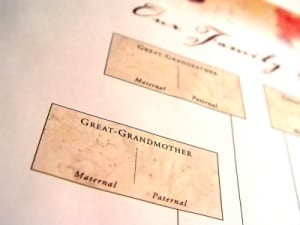
Like many Americans, Vincent Vizachero knew only bits and pieces about his family history. He knew, for instance, that his paternal grandfather emigrated to America from Italy in 1914. But because his grandfather died long before he was born, Vincent did not hear a lot of family stories growing up. So he had to dig them up himself. In his research, Vincent discovered that many people with his surname seemed to have come from the same small region in Italy. He wanted to find out if all people with the Vizachero surname are somehow closely related.
The more he dug, however, the more roadblocks appeared in his way. Three generations of civil and parish records in his grandfather’s hometown from the late 19th century were destroyed during World War II. There was a gap between 1860 and 1910 where no information existed.
Problems like these often arise with genealogical research. But instead of giving up, Vincent decided to turn to another method – genetics.
As it turns out, Vincent is not alone. Many genealogy buffs use genetics to enhance their research on family history. In 2005, a group of genealogists formed the International Society of Genetic Genealogy (ISOGG), kicking off a grassroots effort to incorporate genetic data into the fold of genealogy. By this time, companies like Family Tree DNA had been offering genetic testing for about five years, giving genealogists who had pored over historical records for years a completely new kind of information.
Many used DNA from the Y-chromosome, which is passed from father to son the same way surnames are passed down from one generation to the next. Communities began to form, taking genetic data and trying to relate it to their own family histories rather than the broader scale addressed by academic researchers. ISOGG began developing a ‘family tree’ based on genetic data from thousands of Y-chromosomes from hundreds of families around the world. Some genealogists, like Adriano Squecco, have worked tirelessly to organize these data together into a sharable format for anyone to view.
As data from thousands of individuals began rolling in, communities realized that many of the results coming back were quite similar — most people were being classified within very common branches of the Y-chromosome tree. The people with the most interesting or unique DNA were usually not getting themselves tested.
Instead of waiting for academic researchers to find and genotype these individuals, a few enterprising genealogists, including Vincent Vizachero, decided to take matters into their own hands. They started a fundraising effort, where people can donate money to buy the 23andMe Personal Genome Service for individuals with potentially interesting or unique genetic ancestry. At first they tested more people of western European ancestry, to add detail in that already well-known part of the Y-chromosome tree. Now they are focusing their efforts on testing people of African descent, in an attempt to flesh out the genetic ancestry of the notoriously under-studied continent. The major organizers of the effort have set up a website to keep track of their fundraising, along with periodic updates on their progress.
But why have Vincent and the other organizers chosen 23andMe’s Personal Genome ServiceTM , when there are so many different companies that test genetic ancestry? “The decision was really about cost-effectiveness,” says Vincent. “23andMe is including over 1,800 usable Y-SNPs for less than $400. So the 23andMe service allows us to cover a lot of ground much more quickly than any other method of testing would allow.”
In addition, 23andMe allows customers to download their raw data. While the casual customer may not use this feature, genetic genealogists relish the fact that their raw data is available for them to examine and manipulate.
What’s more, 23andMe provides other hereditary information that can be of interest to genealogists. Some are using 23andMe to examine hereditary health and traits issues within their family trees. And with the Family Inheritance feature, customers can see how various traits have been passed from generation to generation.
For genealogists, a thriving community is vital. Such communities have been the cornerstone of traditional genealogical research for many years, and the addition of genetic data has only compounded their importance. Genealogists have even been able to contribute to science by helping identify new branches to the genetic family tree. As their fundraising project continues to gain steam, Vincent and the other project organizers are pleased with the amount of information they have been able to extract, and how important the genealogy community is in fostering its development. We at 23andMe recognize the importance of working with the genetic genealogy community and ISOGG to provide our customers, and we are thrilled that we can help this community flourish!